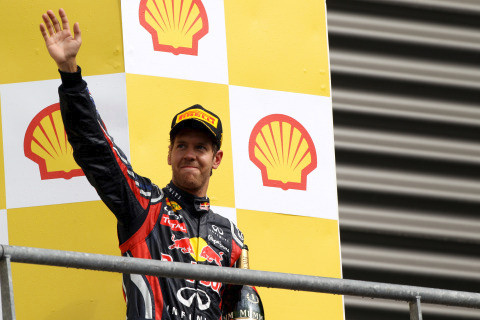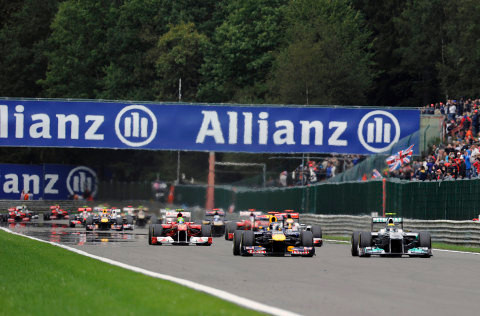That Way It Is/ The height of the F1 season
by Gordon Kirby For many race fans around the world Formula One is at the height of its season. Spa last weekend and Monza the week after next are two of the most historic and respected Grand Prix circuits and these days the Belgian and Italian Grands Prix are the last two classic European races of the F1 season. Both are breathtakingly fast tracks and Spa-Francorchamps is the last of the great European open road circuits run mostly on real public roads closed for race weekends.
For many race fans around the world Formula One is at the height of its season. Spa last weekend and Monza the week after next are two of the most historic and respected Grand Prix circuits and these days the Belgian and Italian Grands Prix are the last two classic European races of the F1 season. Both are breathtakingly fast tracks and Spa-Francorchamps is the last of the great European open road circuits run mostly on real public roads closed for race weekends.
The three other remaining classic European Grand Prix tracks are Monza, Monaco and Silverstone. Monza is a purpose-built road circuit in a former royal park, opened in 1922, while Monaco is the world's classic downtown street circuit dating back to 1929. Silverstone was built on the site of a WWII airfield using the old runways and opened in 1948, hosting the first race in the newly-constituted F1 World Championship in 1950.
The original nine-mile Spa circuit was used for the first time in 1924 and was the scene of the Belgian GP through 1970 when it was removed from the F1 calendar for safety reasons. From 1970-'82 it was replaced by first Nivelles and then the dreadful Zolder track--a complete contrast to Spa in all ways. But a revised, shortened and slightly sanitized 4.3-mile contemporary Spa layout was reintroduced in 1983 and remains as the home of the Belgian GP despite ongoing scuffles with Bernie Ecclestone over money.
Since it was first used in 1924 Spa has also hosted a 24-hour race for touring or GT cars which continues to this day. A 1,000KM World Sports Car championship race was also held at Spa from 1966-'90. Located in the Ardennes Forest in southwestern Belgium the track is less than 100KM from the Nurburgring and, like the 'Ring', rain and changeable weather are facts of life at Spa, integral to the track's character and the challenge of racing there.

© LAT USA
Four years later Spa was dropped from the F1 schedule and when it returned more than a dozen years later it had been reduced by half. Gone was the unbelievably fast section from Les Combes through Burneville, Malmedy, the legendary Masta Kink and Stavelot--the essence of the original circuit.
As every American race fan knows when Dan Gurney won at Spa in 1967 he became only the second American driver to win a Grand Prix race driving an American car (the first was Jimmy Murphy aboard a Duesenberg in the 1921 French GP). Dan also established himself as the first and only American to win a world championship F1 race with his own car and team.
Three years earlier Gurney was on the pole at Spa driving a Brabham BT7 and led most of the race before running out of fuel. He went on to win the next race--the French GP at Rouen--but Dan is particularly proud of his achievements at great circuits like Spa and the Nurburgring. He's especially proud of being able to negotiate Spa's legendary Masta Kink without lifting, one of the factors that contributed to his superb showings at the track.
"I don't think anybody else went flat through the Masta Kink, even in those little (1.5 liter) cars," Dan observes. "It was an enormous advantage if you could do that and I was able to do that consistently. I didn't do it every lap, but if someone was drafting you, you could gain a hundred yards on them there. That was a lot, and it was extremely satisfying to be able to do that."
This was before the days of seat belts and shoulder harnesses and the physical effort required the get through the Masta Kink without lifting was considerable, to say the least.
"We were not using seat belts in those days," Gurney recalls. "You had to be locked into the car, so I developed a different style. I liked the steering wheel pretty high. At the very top of it, at twelve o'clock, I'd still be in the seat so I could push on the seat. Straight ahead I wanted to be about one-thirty or two o'clock on my right. My left arm would be locked down in the car. It was elbow against your hip. That way you had leverage against your body so if you were very strong you were able to keep it right where you wanted to be regardless of how much hammering you were going through from the bumps in the road.
"You could push with your right arm and pull with your left," he adds. "You didn't want too much straight up and down, but a little more swinging, like a milk truck, as the guys used to say. You would have a lot of rigidity and strength in that position as opposed to a nine o'clock, three o'clock position, because the road could feed back and move your hands quite a bit. Plus, locked into the car, you're not able to push yourself off the wheel into the seat. On high-speed tracks, or at the 'Ring or other places where you're whistling in there and want to be precise, all these things were very important."

© LAT USA
Different days, to be sure, but today's Spa-Francorchamps remains a tremendous physical and mental challenge. According to Cosworth, a contemporary F1 driver spends only a quarter of each lap at Spa out of the throttle, the lowest proportion of any F1 track. The drivers also spend almost 40% of each lap in top gear, the highest proportion of any track, Monza included. To gain a greater appreciation of a lap at Spa in a modern F1 car here's an extended quote from Mercedes-Benz's press briefing for last weekend's race.
"Turn Two, the left-hand kink which crosses the bridge over the creek named Eau Rouge, is taken at 306 kph, with a lateral G-force of 2.4G; Turn Three, the right-handed uphill sweep, is taken at 303 kph with a lateral G-force of 4G; and Turn Five, the left-hander over the crest, at 296 kph with a lateral G-force of 2G. The cars also undergo significant
vertical loadings through this section: a vertical force of -1.7G in the compression at the bottom of the hill and +1G over the crest. Although the section is taken flat-out, the cars lose approximately 10 kph through the sequence. The series of corners is 535 meters long (7.6% of the lap distance) and is negotiated in 6.4 seconds (6.1% of the 2010 pole time). The sequence from La Source to Les Combes, including the Raidillon, lasts for 23.5 seconds and is the longest full throttle sequence of the entire season.
"This upward vertical acceleration of 1G effectively means the car is weightless as it goes over the crest; contact with the road is therefore assured by downforce alone, and not the weight of the car. However, at such speeds, the downforce generated is approximately 2.5 times car weight. The high levels of vertical acceleration could also compromise engine and gearbox reliability if not accounted for in system designs and installations. The pick-up points in the oil tank must be accurately placed to ensure the pumps are continuously primed during these phases.
"The other major high-speed challenges are Blanchimont (Turn 17), which is taken flat-out at over 300 kph; and the double left-hander at Pouhon (Turns 10 and 11), which are taken in fifth gear at 240 kph, with a lateral G-force of 3.75G. Pouhon is the longest corner on the circuit, lasting for a total of 7.8 seconds."

© LAT USA
"There is a marked contrast between the profiles of Sectors One and Three, and the profile of Sector Two," adds Mercedes-Benz's briefing. "Sector One features just one braking event (for Turn One) and the rest is spent flat-out: of the 2205 meters in this sector, 2050 meters (93 %) are spent at full throttle. Sector Three is similar: of its 2080 meters, 1750 meters (84%) are spent at full throttle, and the only braking event is for the chicane at the end of the lap (Turns 18 and 19). In contrast, Sector Two contains nine of the circuit's 19 corners and features six braking events, with just 60% of the sector spent at full throttle. By way of comparison, last year's pole position time was set at an average speed of 238 kph: the average speed in Sectors One and Three was 259 kph and 262 kph respectively, while the average in Sector Two was 211 kph."
It's not hard to understand why Spa has a tremendous lure for race fans and always attracts big crowds as it did this year even amid persistent rain on Friday and Saturday. The race was run in cool but dry weather and Sebastien Vettel drove another excellent race to score his first win at Spa and seventh of the year. Red Bull teammate Mark Webber finished second after recovering from a bad start while Jenson Button also drove a great race, coming through from the mid-field to finish third ahead of Fernando Alonso. Michael Schumacher enjoyed a good day too, beating teammate Nico Rosberg to fifth place after starting from the back of the grid.
So Vettel and Red Bull are again looking irresistable with Vettel and Webber one-two in points, Vettel with 259 and Webber 167. Alonso is hanging in there ten points behind Webber with Button another eight points behind. Lewis Hamilton fell to fifth in points, three behind teammate Button after colliding with Kamui Kobayashi and crashing. In the manufacturer's championship Red Bull has accumulated 426 points well ahead of McLaren (295) and Ferrari (231).
The weekend after next the F1 teams will be at Monza for the Italian GP. Six more races remain after Italy--Singapore, Japan, South Korea, India, Abu Dhabi and Brazil. F1's global calendar makes it a true world championship and puts it in a class of its own in motor racing. But for now at least, and hopefully for many years to come, the classic European races--Monaco, Silverstone, Spa and Monza--continue to define F1 and help make it the world's greatest and most recognized form of racing.
Auto Racing ~ Gordon Kirby
Copyright 2011 ~ All Rights Reserved
Copyright 2011 ~ All Rights Reserved
Top of Page